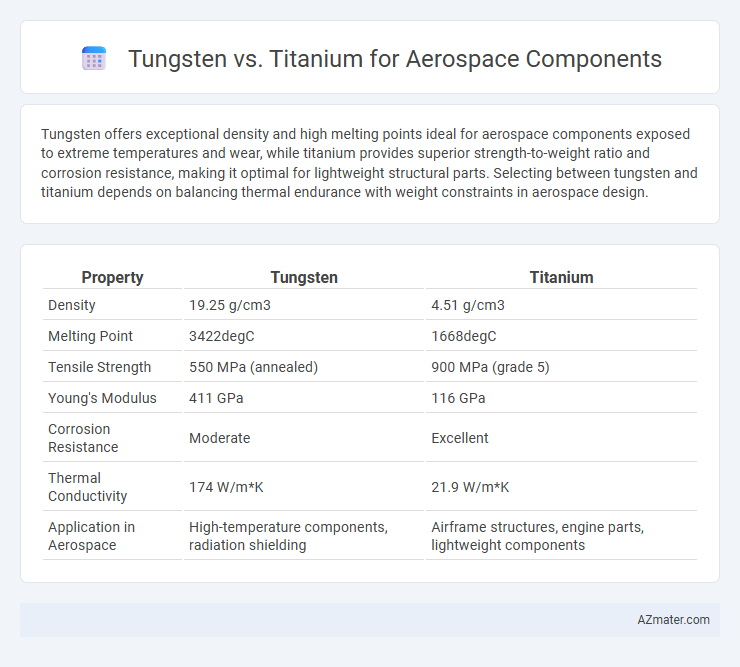Tungsten offers exceptional density and high melting points ideal for aerospace components exposed to extreme temperatures and wear, while titanium provides superior strength-to-weight ratio and corrosion resistance, making it optimal for lightweight structural parts. Selecting between tungsten and titanium depends on balancing thermal endurance with weight constraints in aerospace design.
Table of Comparison
| Property | Tungsten | Titanium |
|---|---|---|
| Density | 19.25 g/cm3 | 4.51 g/cm3 |
| Melting Point | 3422degC | 1668degC |
| Tensile Strength | 550 MPa (annealed) | 900 MPa (grade 5) |
| Young's Modulus | 411 GPa | 116 GPa |
| Corrosion Resistance | Moderate | Excellent |
| Thermal Conductivity | 174 W/m*K | 21.9 W/m*K |
| Application in Aerospace | High-temperature components, radiation shielding | Airframe structures, engine parts, lightweight components |
Introduction to Tungsten and Titanium in Aerospace
Tungsten and titanium are critical materials in aerospace engineering due to their unique physical properties. Tungsten offers exceptional density and high melting points, making it ideal for components requiring high heat resistance and strength, such as engine parts and radiation shielding. Titanium is prized for its high strength-to-weight ratio, corrosion resistance, and biocompatibility, commonly used in airframe structures, landing gears, and turbine blades to reduce weight while maintaining durability.
Material Properties: Tungsten vs Titanium
Tungsten exhibits exceptional density (19.25 g/cm3) and the highest melting point among metals (3422degC), offering superior thermal stability and wear resistance critical for aerospace components exposed to extreme environments. Titanium, with a lower density (4.51 g/cm3) and melting point (1668degC), provides excellent strength-to-weight ratio, corrosion resistance, and fatigue performance, making it ideal for lightweight structural parts. The choice between tungsten and titanium depends on balancing tungsten's high-temperature capabilities and mass with titanium's lightweight durability and resistance to oxidation.
Strength and Weight Comparison
Tungsten exhibits exceptional strength with a tensile strength of around 1510 MPa, but its density of 19.25 g/cm3 makes it significantly heavier compared to titanium, which has a tensile strength ranging from 680 to 1400 MPa depending on the alloy and a much lower density of about 4.5 g/cm3. Titanium alloys, widely used in aerospace components due to their high strength-to-weight ratio, provide superior weight savings and corrosion resistance while maintaining adequate strength for structural applications. The balance of titanium's lighter weight and sufficient tensile strength makes it the preferred choice over tungsten for most aerospace components where weight reduction is critical.
Corrosion Resistance in Aerospace Environments
Tungsten exhibits excellent corrosion resistance in aerospace environments due to its stable oxide layer, which protects against oxidation and chemical degradation at high altitudes. Titanium outperforms tungsten in resisting corrosion from moisture and salt exposure, particularly in marine and humid aerospace conditions, thanks to its naturally forming titanium oxide passivation layer. The choice between tungsten and titanium depends on specific environmental factors and operational demands, with titanium generally favored for its superior overall corrosion resistance combined with lower density.
Thermal Stability and Heat Resistance
Tungsten exhibits exceptional thermal stability and heat resistance, maintaining strength at temperatures exceeding 3,400degC, making it ideal for aerospace components exposed to extreme heat environments. Titanium, while possessing lower melting points around 1,668degC, offers a superior strength-to-weight ratio and excellent corrosion resistance, suitable for moderate thermal conditions in aerospace applications. The choice between tungsten and titanium hinges on balancing the need for extreme thermal endurance against weight constraints and mechanical performance in aerospace component design.
Machinability and Manufacturing Processes
Tungsten offers exceptional strength and high melting points ideal for aerospace components exposed to extreme temperatures, but its low machinability requires advanced manufacturing techniques such as electrical discharge machining (EDM) or laser cutting. Titanium provides superior machinability with easier cutting and shaping processes, making it preferable for components requiring intricate designs and faster production cycles. Manufacturing processes for titanium typically involve conventional milling, turning, and additive manufacturing, enabling efficient fabrication while balancing strength-to-weight ratios essential in aerospace applications.
Cost Analysis: Tungsten vs Titanium Components
Tungsten components in aerospace applications typically incur higher manufacturing costs due to the metal's extreme hardness and melting point, which demand specialized machining processes and equipment. Titanium offers a cost advantage with easier fabrication and lower material expenses, despite higher raw material prices, making it more economically viable for large-scale aerospace production. Lifecycle costs also favor titanium, as its superior corrosion resistance and strength-to-weight ratio reduce maintenance and fuel expenses over time.
Applications of Tungsten in Aerospace
Tungsten's high density and exceptional thermal resistance make it ideal for aerospace components exposed to extreme temperatures and mechanical stress, such as rocket engine nozzles, radiation shielding, and counterweights. Its superior hardness and low thermal expansion enhance durability and stability in critical aerospace applications requiring precision and reliability. Tungsten's ability to withstand intense heat and corrosion without degrading ensures long-term performance in high-stress environments compared to other metals like titanium.
Applications of Titanium in Aerospace
Titanium is extensively used in aerospace components due to its exceptional strength-to-weight ratio, corrosion resistance, and ability to withstand high temperatures. It is commonly applied in aircraft structural parts, engine components, and landing gear to reduce weight and enhance fuel efficiency. Titanium alloys also contribute to improved durability and performance in both commercial and military aerospace applications.
Choosing the Right Material for Aerospace Components
Tungsten offers exceptional density and high melting points, making it ideal for aerospace components requiring extreme heat resistance and radiation shielding. Titanium provides a superior strength-to-weight ratio and excellent corrosion resistance, crucial for lightweight structural parts and fuel-efficient designs. Selecting the right aerospace material depends on specific performance demands such as thermal stability, weight constraints, and mechanical strength requirements.

Infographic: Tungsten vs Titanium for Aerospace Component
 azmater.com
azmater.com